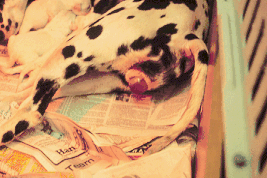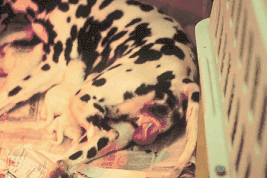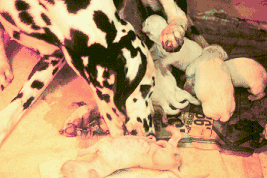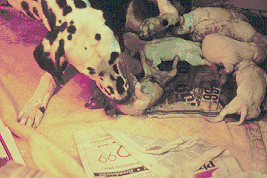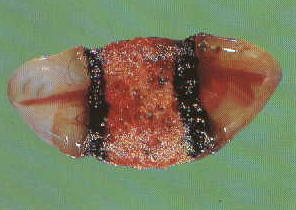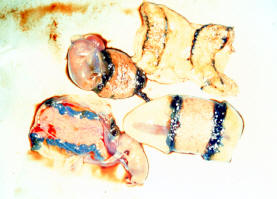There seems to be very little correlation between uterine contractions and signs that the bitch is pushing and/or having contractions.Canine Neonateology
Adapted from A. P. Davidson
Clinical Theriogenology 2009 Vol.1 No.1 57-63
· Neonatal survival
o Neonatal period defined as the first 4 to 6 weeks of life
o Average reported neonatal puppy and kitten mortality rates vary, ranging from 9 to 26% (greatest during the first week of life).
o Most commonly neonates die within first three days.
· Neonatal Physiology
o Cardiovascular
§ Heart innervation - incompletely developed and anticholinergic response minimal.
§ Prior to 4 days hypotension results from anoxia because baroreceptor reflexes absent.
· More appropriate to supplement oxygen than to administer parasympatholytic agents (atropine), which will exacerbate cardiac hypoxemia via increasing oxygen demand in the face of hypoxemia.
§ Fetuses, and nonates in the first 4 days of life - bradycardia not vagally mediated and is indicative of hypoxemia.
o Respiratory
§ During the first 3 days, genital or umbilical stimulation induces reflex respiration - clinically used to stimulate respiration in the immediate post partum period.
§ Normal respiratory rate during the first week is low (10-18 breaths per minute), despite high metabolic oxygen demand.
§ Respiratory control function mechanisms (carotid body chemoreceptors) develop before birth, but require post natal maturation.
· Very susceptible to the development of hypoxemia and/or jeopardized ventilation and gas exchange due to the immaturity of chemoreceptor responses to hypoxia
§ High chest wall compliance in neonates means work and pressure to maintain tidal breathing is increased as compared to that of the adult.
· Very susceptible to the development of hypoxemia and/or jeopardized ventilation and gas exchange due to the chest wall construction.
§ Hypoxemia may result in life threatening septic shock due despite a lack of mucosal lesions.
§ It is vital that the environment be kept free of airway irritants and oxygenation is adequate.
o Hematopoietic
§ Neonatal red blood cell is macrocytic, with corpusclar volume decreasing to that of the adult by 4 weeks, as fetal RBCs are replaced by adult RBCs.
· As fetal RBCs are replaced polychromasia and increased reticulocyte counts may be seen.
· Microcytosis is suggestive of iron deficiency anemia (check for ectoparasites)
§ Neonatal hematocrit may be as high as 60 per cent, yielding the red mucous membrane color often noted at birth.
· By 3 days RBCs decrease dramatically and continue to decrease for around 3 weeks.
· Adult RBC count, hemoglobin, and hematocrit are generally not detected until 6 months .
§ Neonatal isoerythrolysis is uncommon in the cat and rare in the dog.
· Feline - associated with type A kitten born to a type B queen that has anti-A alloantibodies (agglutinating and hemolytic).
§ White blood cell parameters similar to adults.
§ Lymphocytosis - may be noted in the normal neonate.
§ Extramedullary hematopoeisis - common in neonatal liver.
o Urinary system
§ Neonatal kidney morphologically and functionally immature
· Nephrogenesis continues for 2 weeks after birth.
§ Neonatal kidney functionally characterized by:
· Low glomerular filtration rate (GFR.)
· Low renal plasma flow (RPF)
· Low filtration fraction (FF)
· Depressed reabsorption of amino acids and phosphate
o Detection of protein, glucose and various amino acids due to the immaturity of the proximal tubule normal.
o By 3 weeks urine protein and glucose concentrations similar to adult dog and urine concentration is expected to compare to that of the adult dog by six to eight weeks of age.
· Exaggerated proximal tubule natriuresis
· Low concentrating ability.
o Low urine specific gravity (1.006 - 1.0017) is normal.
o By 6 weeks urine concentration is expected to compare to that of the adult dog.
o
§ Serum creatinine and blood urea nitrogen (BUN) concentrations - lower than adult animal
· Creatinine 0.4 mg/dl
· BUN 8-10 mg/dl
§ Serum phosphorous concentrations elevated
· 9 mg/dl
· Due to skeletal growth.
§ Arterial pressure is low (50 - 60 mmHg) at birth
· Increase in GFR and RPF results from increased blood pressure and decreased vascular resistance during renal maturation.
· Renal blood flow - directly correlated with arterial pressure
o Not altered by inhibition of angiotensin until around 6 weeks.
§ Fluid therapy
· 60-180 ml/kg/day
§ Renally excreted or metabolized antimicrobials (penicillin, ampicillin, cephalosporins, fluroquinolones, and aminoglycosides)
· 6-Lactam antibiotics (penicillins, cephalosporins)
o Drugs of choice
o Half-life may be prolonged there is a large therapeutic margin.
o Ceftiofur administered at 2.5mg/kg SQ q12h, maximum five days is an acceptable antimicrobial choice.
§ Nonsteroidal anti-inflammatories
· Altered metabolism in neonate
· Potential for renal toxicity in neonates -far greater than in the adults.
o Hepatobiliary system
§ Ductus venosus shunts blood through the liver, bypassing the neonatal sinusoid s during gestation
§ Maternal placenta supports many functions performed by the liver and biliary system in the adult animal.
§ Neonatal liver and biliary system is functionally immature at birth.
§ Reduction in bile flow in the newborn puppy as compared to the adult dog
§ Failure of secretion and glucagon to stimulate bile flow at 3-28 days of age.
§ Function tests
· Serum bile acids may be used to detect hepatocirculatory abnormalities as young as four weeks, despite a relative functional cholestasis
· Alkaline phosphatase (ALP)
o Markedly elevated < 2 weeks old
o Moderately elevated > 2 weeks of age
o Elevations attributed to placental, colostral, and intestinal activity.
o Physiologically elevated during skeletal growth.
o May be indicative of colostrum intake and potentially passive transfer.
· gamma- glutamyltransferase (GGT)
o Markedly elevated < 2 weeks old
o Moderately elevated > 2 weeks of age
o Elevations attributed to placental, colostral, and intestinal activity.
· Aspartate aminotransferase (AST)
o Comparable to that of the adult
· Alanine aminotransferase (ALT)
o Comparable to that of the adult.
· GOT increases may be indicative of colostrum intake and potentially passive transfer.
§ Microsomal enzyme activities at 4 weeks 85% of that seen in an adult dog.
· Adult levels of activity by 4.5 months
· detection of serum increases in GOT and ALP in the newborn may be indicative of colostrum intake and potentially passive transfer.
§ With undeveloped microsomal and P450 enzyme activity until 4to 5 months care must be exercised when using drugs that require hepatic metabolism or excretion.
o Gastrointestinal system
§ Tract is sterile at birth
§ Neutral gastric pH at birth - care must be taken if administering oral drug therapy
§ Time-dependent increased permeability of the intestinal mucosa that decreases dramatically after ten hours. Care must be taken if administering oral drug therapy.
§ Normal nursing pup feces are semi-formed and tan in color (acholic).
§ GI motility before 30-40 days - dependent upon pressure gradients rather than electrical intestinal motility.
§ Body temperature has an effect on gastrointestinal movement
· Below 94 °F, ileus develops.
o As ileus progresses, the willingness to nurse decreases and the necessity for tube feeding puppies increases.
§ Dentition eruption first occurs at 2to 3 weeks
§ All deciduous teeth should be present by 12 to -16 weeks.
o Immune system
§ At birth - antibody deficient and immunologically incompetent.
· Acquisition of passive immunity requires ingestion and absorption of colostrum during the first 24 hours.
· 5 to 10% of serum antibodies derived from trans-placental transfer.
§ Puppies can produce challenge specific antibodies within 2 weeks.
· With repeated challenge can produce a secondary immune response at 40 days.
· Even by 40 days of age, T cell mitogenesis and differentiation, and phagocytic cell function systems may not be fully mature.
§ When colostral intake is not possible or is of questionable quality, pooled adult dog serum (20-150 ml/kg SC divided) may be administered .
o Neurologic system
§ Sleeping and nursing - main activities during the first 2 weeks.
· Rooting reflex orients the neonate to its source of food, the dam.
· EEG of the neonatal puppy initially is similar during periods of sleep and waking.
§ Vestibular function present at birth - important for positioning during nursing.
§ Muscular coordination absent.
· Initial movements characterized by swimming-like movements of the limbs, while sliding along on the ventral abdomen and thorax.
· Ability to raise head is present at birth in puppies and the head may be used initially for righting reflex. Upright posture in puppies cannot be maintained until ten to 14 days.
· Body posture is primarily flexion at birth
o If suspended by the head, flexor hypertonicity is present.
· At 4 to 5 days flexor hypertonicity replaced by extension until 3 to 4 weeks
§ Nociceptive threshold is much lower than in adults.
· Lack of some of the descending inhibitory mechanisms found in older animals??
§ Coordination of motor responses to noxious stimuli not well-developed - may have much wider receptive fields to noxious events.
· Pain is perceived by the neonate subjected to noxious stimuli.
o Procedures on neonates with insufficient pain control produce greater stress responses than those where analgesia has been provided.
o Local anesthetic (lidocaine, dose extrapolated from humans) can be used
§ Dose is lower due to immaturity of the nerves
§ Not appear to be at any greater risk of toxic side effects with a single dose of lidocaine.
§ Bupivicaine is not advised - the risk of cardiotoxicity with overdosage.
§ Opioid analgesics
· Different pharmacokinetics than adult.
· Lower doses required for analgesia at 1 day of age compared with 34 days (3to 4-fold differences).
o Metabolism
§ Normal birth weight of the puppy - breed dependent
· 500 gm ±150 gm for a medium breed dog.
· < 300 gm in the medium size dog - associated with an increased risk of neonatal mortality.
o Increased mortality associated with negative effects of chilling (higher body surface area: mass) and the ability to nurse and maintain glucose concentrations.
§ Growth pattern
· Most rapid weight gain occurring during the first 12 weeks.
· Puppies should gain on average 10% of their body weight each day for the first few weeks of life (1 gm/3 expected adult weight).
o One of the first signs of illness is a failure to gain weight.
o Often noted well before any other clinical signs of disease are present.
o Twice daily weighing of neonates during the first week(s) of life dramatically facilitates early detection of illness
§ Ensures adequate intervention in a timely manner to prevent poor weight gain and positively impacts neonatal survival.
§ Neonates are poikilothermic.
· Normal rectal temperatures 95 - 99 °F (week one), 97-100 °F (weeks 2 and 3) and by weaning rectal temperatures approach that of the adult.
· Well- developed behavioral heat-seeking responses
o Maintain a stable rectal temperature if heat is available.
· Shivering and vasoconstrictive reflexes are not functional in the newborn.
· Physiological responses seen during hypothermia include bradycardia, cardiovascular failure, neuronal injury, and ileus.
§ During the first 3 to 24 hours after birth, hepatic glycogen stores decline by more than 50% and there is a shift from glycogenolysis to a mixture of glycogenolysis and gluconeogenesis.
§ For maintenance of blood glucose regular feeding is required.
o Syndromes
§ Fading Puppies
· Dies following the onset of rapidly progressive, vague signs of illness.
· Premortem diagnosis challenging.
· Immediate necropsy
o Clients should be advised to refrigerate (not freeze) deceased neonates and present them promptly for evaluation.
· Neonatal bacterial peritonitis with septicemia
o Rapid deterioration of the puppy resulting in death
o Predisposing factors
§ Endometritis in the bitch
§ Prolonged (often not recognized or reported) delivery/dystocia
§ Feeding replacement formulas
§ Usein ampicillin
§ Stress
§ Low birth weight (< 350 gms)
§ Chilling with body temperature <35.5 °C.
o Umbilicus should be treated with tincture of iodine immediately after birth to reduce contamination and prevent ascent of environmental bacteria into the peritoneal cavity (omphalitis-peritonitis).
o Bacterial organisms
§ E. coli
§ Streptococci
§ Staphylococci
§ Klebsiella
o Signs
§ Decrease in weight gain
§ Failure to suckle
§ Hematuria
§ Persistent diarrhea
§ Unusual vocalization
§ Abdominal distention and pain
§ Sloughing of the extremities
o Treatment
§ Broad spectrum, bactericidal antibiotics.
· Third generation antibiotic, ceftiofur sodium
o Alters normal intestinal flora minimally
o Usually effective against the causative organisms.
§ Optimal nutrition via supported nursing, tube feeding or bottle-feeding
§ Maintenance of body temperature
§ Appropriate fluid replacement
§ The prognosis for septicemic neonates is poor
· Canine herpesvirus (CHV)
o Widely recognized and commonly blamed cause of fading puppy syndrome
o Premortem and postmortem diagnosis of CHV infection in neonates can be challenging.
§ Necropsy findings
· Multifocal petechial renal hemorrhages.
o Confoundingly, these can be also be present with bacterial septicemia.
· Intranuclear inclusion bodies can be difficult to find.
· Diagnosis by virus isolation or CHV-specific PCR is confirmatory.
o Treatment
§ Unrewarding and recovery is rare.
· Recovery reported to result in residual cardiac and neurologic damage.
§ Immune serum from affected dams reported to be ineffective in infected puppies.
§ One case report of successful treatment with the antiviral drug, acyclovir exists.
· Antiviral agent
· Preferentially taken up by susceptible viruses and converted into the active triphosphate form, which inhibits viral DNA replication.
· Poorly absorbed after oral administration
· Primarily metabolized by the liver.
· Can increase toxicity of nephrotoxic drugs.
· Half-life in humans is approximately 3 hours.
· Use in veterinary medicine is not well established
· Should be used with caution and only in situations where indicated.
· Safety and effectiveness in humans less than two weeks of age is not established.
· Sose is extrapolated from that for humans.
§ Successful vaccine development been hampered by poor immunogenicity of other herpesviral vaccines developed for other species
§ Neonates of a naive bitch exposed to CHV during the last two to three weeks of gestation or the first three weeks postpartum are at risk.
· Juvenile cellulitis (puppy strangles)
o Progressive, granulomatous, pustular disorder
o Most commonly < 4 months of age
o Occasionally reported in dogs up to four years of age.
o Eyelids, pinnae, lips, chin, muzzle, paws, abdomen, thorax, vulva, prepuce and anus can be affected with lesions that fistulate, drain and crust.
o Lymphadenomegaly, most commonly mandibular and superficial cervical, can be distant from the affected skin sites and is often painful.
o Pustules and lymph nodes are usually sterile when cultured.
o Superficial cutaneous flora can be cultured from open, draining lesions.
o Pyrexia, anorexia, sterile suppurative painful arthritis and and inflammatory hemogram can be seen.
o Diagnosis
§ Confirmed by histopathologic evaluation but is commonly made on the basis of clinical appearance.
· Predominant inflammatory cell is an epithelioid macrophage J
o Treatment
§ Aggressive immunosuppressive therapy early in the course of the disease
· Avoids the sequellae of cicatricial lesions.
§ Prednisone (2.2 mg/kg/day)
§ Griseofulvin
· Effective treatment without the side effects associated with corticosteroid administration
· Enabling discontinuation of corticosteroids sooner in the course of the disease.
· 14.2 to 34 mg/kg PO Q 12 h
· Postulated to induce down regulatory signals within the lesions.
· Sole therapy could be attempted in early cases.
· Vaccination of puppies undergoing immunosuppressive therapy is not advised and they must be strictly isolated from sources of infectious disease.
· Bacterial overgrowth syndrome-associated diarrhea (BOS)
o When normally low bacterial colonization in the upper GI tract
§ Upper GI tract once believed to be sterile, but normal colonization of the duodenum, jejunum, and ileum is now realized.
o Mucosal injury resulting from a minor viral or bacterial gastroenteritis can if a proper post infectious dietary regimen is not followed.
o Particular bacterial pathogen never been implicated
§ Abnormally large numbers of normal or pathological flora appear to be the cause.
§ Normal conditions
· Gram-positive bacteria and fungi colonize the duodenum and jejunum in quantities less than 1 X 105 organisms per milliliter of fluid.
· Aerobic and anaerobic bacteria colonize the ileum in quantities less than 1 X 10 organisms per milliliter of fluid.
§ BOS -
· 1 X 1011 organisms per milliliter of fluid that colonize the colon.
· Duodenal aspirates have not identified any particular bacteria as a cause
· 1 X 105 organisms per milliliter of aspirate fluid is diagnostic.
· Usually, abnormally large numbers of anaerobic bacteria and normal florae grow from cultured fluid of patients with BOS.
§ Protective factors that stabilize the number and type of bacteria that colonize the upper GI tract. Abnormalities put a patient at risk for bacterial overgrowth.
· Two coordinated motor phenomena produce the continuous propulsive peristaltic action of the upper GI
tract.
o Both the migrating motor complex and the migrating action potential complex clear the upper intestine of unwanted bacteria and undigested substances. Desynchronization of these complexes results in diarrhea and weight loss in animal models.
o Neonates lack propulsive peristaltic action.
o Gut motility in neonates results from aboral pressure.
· Gastric acid normally reduces the proximal small intestine bacteria populations, particularly anaerobic
bacteria.
o The bowel mucosa integrity and mucin layer protect the gut from bacteria.
o Neonates have reduced gastric acidity.
· Malabsorption of bile acids, fats, carbohydrates, proteins, and vitamins causes many of the symptoms of
diarrhea and weight loss associated with BOS.
o Anaerobes and Bacteroides fragilis actively deconjugate bile acids, thereby preventing proper bile acid function and enterohepatic circulation.
o Fatty acid absorption is reduced because deconjugated bile acids cannot help micelle formation.
§ The unconjugated bile acids also damage intestinal enterocytes and induce water secretion by the colonic mucosa.
§ Deconjugated bile acids directly inhibit carbohydrate transporters.
o The unabsorbed sugars ferment into organic acids because of the intestinal flora, which reduces the intraluminal pH and produces osmotic diarrhea.
· Fat, protein, carbohydrate, and vitamin malabsorption results from poor enterocyte function and bacterial
transformation of nutrients into nonabsorbable and toxic metabolites.
o Toxic metabolites damage the
intestinal mucosa.
o Malabsorption and enterocyte dysfunction further degrade the health of the gut by
reducing local and systemic nutrition delivery.
o Treatment
§ Reduce the damage caused by malabsorption
§ Restore nutritional health and normal gut flora
§ Prompt recognition and treatment can prevent the development of severe malnutrition.
§ Antimicrobials
· Ampicillin
· Amoxicillin
§ Anasarca
· It is suspected to have a heritable component
o Genetics are not known.
o Thought to be inherited as an autosomal dominant trait.
· Lethal congenital edema
· With or without concurrent cardiovascular abnormalities.
· Signs
o Generalized subcutaneous edema
o Intrathoracic and intraperitoneal fluid.
· Congenital hereditary lymphedema causes edema of the extremities and sometimes head, and is associated with morphologic lymphatic abnormalities.
· Prepartum ultrasonographic evaluation of the fetuses can be used to screen for this disorder to prevent dysotcia.
· Dystocia can result due to fetal oversize.
· Problem common in Bulldogs, but recognized in other breeds as well (Labrador retriever).
· Its exact pathophysiology in the dog is not understood.
· Treatments
o Multiple anecdotal remedies, none proven or reported in the scientific literature.
o Euthanizia.
o Diuretic therapy of affected neonates can sometimes cause slight normalization, but euthanasia is usually indicated if the neonate is not stillborn.
o Environmental, dietary, and pharmacologic contributory factors are not scientifically defined.
o Recognized for many years, yet its incidence remains unchanged.
§ Swimmer puppies
· Fail to develop normal ambulation at 10 to 14 days of life
· Move by paddling their limbs laterally and caudally.
· Compression and deformation of the sternum and thorax occur concurrently.
· Obese puppies from small litters, commonly raised on relatively slippery surfaces are predisposed.
· Treatment
o Instituted immediately upon diagnosis
o Caloric restriction
o Physical therapy
o Improved traction in the nest box.
o If diagnosed early (3to 5 weeks of age) the condition is reversible and does not require binding of puppies.
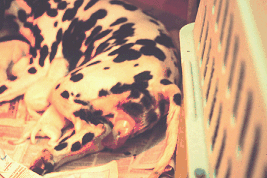
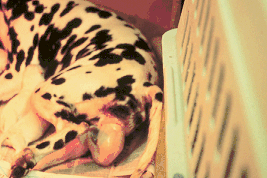
 Next
Page
Next
Page Canine
Index
Canine
Index


